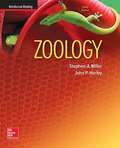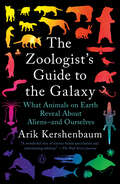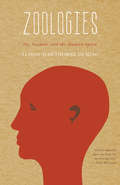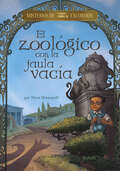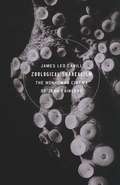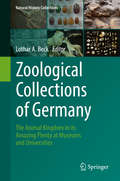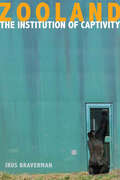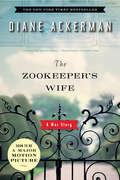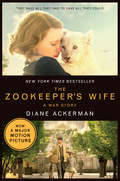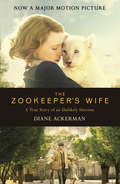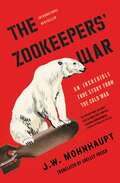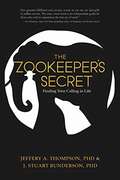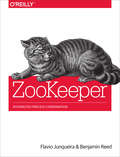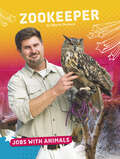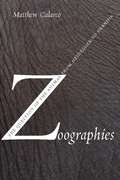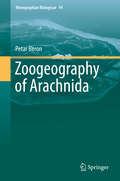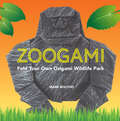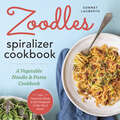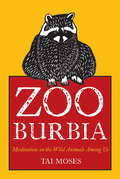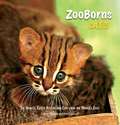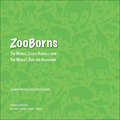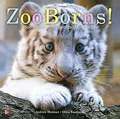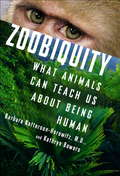- Table View
- List View
Zoology
by Stephen A. Miller John P. HarleyThe new 7th edition of "Zoology" continues to offer students an introductory general zoology text that is manageable in size and adaptable to a variety of course formats. It is a principles-oriented text written for the non-majors or the combined course, presented at the freshman and sophomore level. "Zoology" is organized into three parts. Part One covers the common life processes, including cell and tissue structure and function, the genetic basis of evolution, and the evolutionary and ecological principles that unify all life. Part Two is the survey of protists and animals, emphasizing evolutionary and ecological relationships, aspects of animal organization that unite major animal phyla, and animal adaptations. Part Three covers animal form and function using a comparative approach. This approach includes descriptions and full-color artwork that depict evolutionary changes in the structure and function of selected organ systems.
The Zoologist's Guide to the Galaxy: What Animals on Earth Reveal About Aliens--and Ourselves
by Arik KershenbaumFrom a noted Cambridge zoologist, a wildly fun and scientifically sound exploration of what alien life must be like, using universal laws that govern life on Earth and in space.Scientists are confident that life exists elsewhere in the universe. Yet rather than taking a realistic approach to what aliens might be like, we imagine that life on other planets is the stuff of science fiction. The time has come to abandon our fantasies of space invaders and movie monsters and place our expectations on solid scientific footing.But short of aliens landing in New York City, how do we know what they are like? Using his own expert understanding of life on Earth and Darwin's theory of evolution--which applies throughout the universe--Cambridge zoologist Dr. Arik Kershenbaum explains what alien life must be like: how these creatures will move, socialize, and communicate. For example, by observing fish whose electrical pulses indicate social status, we can see that other planets might allow for communication by electricity. As there was evolutionary pressure to wriggle along a sea floor, Earthling animals tend to have left/right symmetry; on planets where creatures evolved in midair or in soupy tar, they might be lacking any symmetry at all.Might there be an alien planet with supersonic animals? A moon where creatures have a language composed of smells? Will aliens scream with fear, act honestly, or have technology? The Zoologist's Guide to the Galaxy answers these questions using the latest science to tell the story of how life really works, on Earth and in space.
Zoologies: On Animals and the Human Spirit
by Alison Hawthorne DemingHumans were surrounded by other animals from the beginning of time: they were food, clothes, adversaries, companions, jokes, and gods. And yet, our companions in evolution are leaving the world - both as physical beings and spiritual symbols - and not returning. In this collection of linked essays, Alison Hawthorne Deming asks, and seeks to answer: what does the disappearance of animals mean for human imagination and existence? Moving from mammoth hunts to dying house cats, she explores profound questions about what it means to be animal. What is inherent in animals that leads us to destroy, and what that leads us toward peace? As human animals, how does art both define us as a species and how does it emerge primarily from our relationship with other species? The reader emerges with a transformed sense of how the living world around us has defined and continues to define us in a powerful way.
El zoológico con la jaula vacía
by Steve BrezenoffEdward G. Garrison, más conocido como Egg, está deseando ir de excursión al zoológico con el club de ciencias. Allí verán una exposición única de zorros isleños, una especie en peligro de extinción. Pero cuando llegan, ¡descubren que alguien se ha robado los zorros! ¿Podrán Egg y sus amigos encontrarlos?
Zoological Surrealism: The Nonhuman Cinema of Jean Painlevé
by James Leo CahillAn archive-based, in-depth analysis of the surreal nature and science movies of the pioneering French filmmaker Jean PainlevéBefore Jacques-Yves Cousteau, there was Jean Painlevé, a pioneering French scientific and nature filmmaker with a Surrealist’s eye. Creator of more than two hundred films, his studies of strange animal worlds doubled as critical reimaginations of humanity. With an unerring eye for the uncanny and unexpected, Painlevé and his assistant Geneviève Hamon captured oneiric octopuses, metamorphic crustaceans, erotic seahorses, mythic vampire bats, and insatiable predatory insects. Zoological Surrealism draws from Painlevé’s early oeuvre to rethink the entangled histories of cinema, Surrealism, and scientific research in interwar France. Delving deeply into Painlevé’s archive, James Leo Cahill develops an account of “cinema’s Copernican vocation”—how it was used to forge new scientific discoveries while also displacing and critiquing anthropocentric viewpoints. From Painlevé’s engagements with Sergei Eisenstein, Georges Franju, and competing Surrealists to the historiographical dimensions of Jean Vigo’s concept of social cinema, Zoological Surrealism taps never-before-examined sources to offer a completely original perspective on a cutting-edge filmmaker. The first extensive English-language study of Painlevé’s early films and their contexts, it adds important new insight to our understanding of film while also contributing to contemporary investigations of the increasingly surreal landscapes of climate change and ecological emergency.
Zoological Collections of Germany: The Animal Kingdom in its Amazing Plenty at Museums and Universities
by Lothar A. BeckProvides a timely compilation of German zoological collections.<P><P> Casts new light on endangered zoological collections and explores modern exhibition concepts.<P> Maximizes readers insight into the zoological collection network.<P> This book is devoted to the knowledge of up to 250 years of collecting, organizing and preserving animals by generations of scientists. Zoological Collections are a huge resource for modern animal research and should be available for national and international scientists and institutions, as well as prospective public and private customers. Moreover, these collections are an important part of the scientific enterprise, supporting scientific research, human health, public education, and the conservation of biodiversity. Much of what we are beginning to understand about our world, we owe to the collection, preservation, and ongoing study of natural specimens. Properly preserved collections of marine or terrestrial animals are libraries of Earth's history and vital to our ability to learn about our place in its future.<P> The approach employed by the editor involves not only an introduction to the topic, but also an external view on German collections including an assessment of their value in the international and national context, and information on the international and national collection networks. Particular attention is given to new approaches of sorting, preserving and researching in Zoological Collections as well as their neglect and/or threat. In addition, the book provides information on all big Public Research Museums, on important Collections in regional Country and local District Museums, and also on University collections.<P> This is a highly informative and carefully presented book, providing scientific insight for readers with an interest in biodiversity, taxonomy, or evolution, as well as natural history collections at larg
Zooland: The Institution of Captivity
by Irus BravermanThis book takes a unique stance on a controversial topic: zoos. Zoos have their ardent supporters and their vocal detractors. And while we all have opinions onwhatzoos do, few people considerhowthey do it. Irus Braverman draws on more than seventy interviews conducted with zoo managers and administrators, as well as animal activists, to offer a glimpse into the otherwise unknown complexities of zooland. Zoolandbegins and ends with the story of Timmy, the oldest male gorilla in North America, to illustrate the dramatic transformations of zoos since the 1970s. Over these decades, modern zoos have transformed themselves from places created largely for entertainment to globally connected institutions that emphasize care through conservation and education. Zoos naturalize their spaces, classify their animals, and produce spectacular experiences for their human visitors. Zoos name, register, track, and allocate their animals in global databases. Zoos both abide by and create laws and industry standards that govern their captive animals. Finally, zoos intensely govern the reproduction of captive animals, carefully calculating the life and death of these animals, deciding which of them will be sustained and which will expire. Zoolandtakes readers behind the exhibits into the world of zoo animals and their caretakers. And in so doing, it turns its gaze back on us to make surprising interconnections between our understandings of the human and the nonhuman.
The Zookeeper's Wife: A War Story (Thorndike Biography Ser. #0)
by Diane Ackerman<P>The New York Times bestseller: a true story in which the keepers of the Warsaw Zoo saved hundreds of people from Nazi hands. After their zoo was bombed, Polish zookeepers Jan and Antonina Zabinski managed to save over three hundred people from the Nazis by hiding refugees in the empty animal cages. With animal names for these "guests," and human names for the animals, it's no wonder that the zoo's code name became "The House Under a Crazy Star." <P>Best-selling naturalist and acclaimed storyteller Diane Ackerman combines extensive research and an exuberant writing style to re-create this fascinating, true-life story--sharing Antonina's life as "the zookeeper's wife," while examining the disturbing obsessions at the core of Nazism. <P><b>Winner of the 2008 Orion Award.</b> <P><b>A New York Times Bestseller</b>
The Zookeeper's Wife: A War Story (Movie Tie-in Editions #0)
by Diane Ackerman<P>The movie The Zookeeper’s Wife, based on the New York Times bestselling book, opens March 2017. <P>1939: the Germans have invaded Poland. The keepers of the Warsaw zoo, Jan and Antonina Zabinski, survive the bombardment of the city, only to see the occupiers ruthlessly kill many of their animals. The Nazis then carry off the prized specimens to Berlin for their program to create the “purest” breeds, much as they saw themselves as the purest human race. Opposed to all the Nazis represented, the Zabinskis risked their lives by hiding Jews in the now-empty animal cages, saving as many as three hundred people from extermination. <P>Acclaimed, best-selling author Diane Ackerman, fascinated both by the Zabinskis’ courage and by Antonina’s incredible sensitivity to all living beings, tells a moving and dramatic story of the power of empathy and the strength of love. <P>A Focus Features release, it is directed by Niki Caro, written by Angela Workman.
The Zookeeper's Wife: An unforgettable true story, now a major film (Movie Tie-in Editions Ser. #0)
by Diane AckermanIn war-torn Warsaw, a zookeeper and his wife refuse to surrender... Now a major motion picture starring Jessica Chastain and Daniel Brühl, Diane Ackerman's The Zookeeper's Wife is based on a remarkable true story of bravery and sanctuary during World War II. Perfect for fans of Lion and Hidden Figures. 'I can't imagine a better story or storyteller. The Zookeeper's Wife will touch every nerve you have' -Jonathan Safran Foer, author of Everything is Illuminated When Germany invades Poland, Luftwaffe bombers devastate Warsaw and the city's zoo along with it. With most of their animals killed, or stolen away to Berlin, zookeepers Jan and Antonina Zabinski begin smuggling Jews into the empty cages.As the war escalates Jan becomes increasingly involved in the anti-Nazi resistance. Ammunition is buried in the elephant enclosure and explosives stored in the animal hospital. Plans are prepared for what will become the Warsaw uprising. Through the ever-present fear of discovery, Antonina must keep her unusual household afloat, caring for both its human and animal inhabitants - otters, a badger, hyena pups, lynxes - as Europe crumbles around them.Written with the narrative drive and emotional punch of a novel, The Zookeeper's Wife is a remarkable true story. It shows us the human and personal impact of war - of life in the Warsaw Ghetto, of fighting in the anti-Nazi resistance. But more than anything it is a story of decency and sacrifice triumphing over terror and oppression. What readers are saying about The Zookeeper's Wife: 'Beautifully and sensitively written - a must read''An adventure that inspires''Both horrifying and endearing on a scale I've not experienced in years''A story that will haunt you forever''Haunting, life affirming, sad, and inspiring'
The Zookeepers' War: An Incredible True Story from the Cold War
by J.W. MohnhauptTHE ACCLAIMED INTERNATIONAL BESTSELLER The unbelievable true story of the Cold War&’s strangest proxy war, fought between the zoos on either side of the Berlin Wall.Living in West Berlin in the 1960s often felt like living in a zoo, everyone packed together behind a wall, with the world always watching. On the other side of the Iron Curtain, the East Berlin zoo was spacious and lush, a socialist utopia where everything was perfectly planned...and then rarely successfully finished. Berlin&’s two zoos quickly became symbols of the divided city&’s two halves. And so no one was terribly surprised when the head zookeepers on either side started an animal arms race—rather than stockpiling nuclear warheads, competing to have the most pandas and hippos. Soon, state funds were being quietly diverted to give these new animals lavish welcomes worthy of visiting dignitaries. West German presidential candidates were talking about zoo policy on the campaign trail. And eventually politicians on both side of the Wall became convinced that if their zoo were proved to be inferior, then that would mean their country&’s whole ideology was too. A quirky piece of Cold War history unlike anything you&’ve heard before, The Zookeepers&’ War is an epic tale of desperate rivalries, human follies, and an animal-mad city in which zookeeping became a way of continuing politics by other means.
The Zookeeper's Secret: Finding Your Calling in Life
by J. Stuart Thompson Jeffery A. BundersonPerhaps your professional and other life ambitions are simply a means to an end—a way to pay the bills or pursue a lifestyle. But what if there was something more? What if you could have success and fulfillment in equal measure? In response to these fundamental questions, Professors Jeff Thompson and Stuart Bunderson draw on research, personal experience, and gospel truths to dispel common myths that can stand in the way of seeking your true calling, the work that brings the greatest meaning and satisfaction to your life. Is there only one true calling for you? Can you still find your calling if you choose to stay at home? What if your calling doesn’t pay enough to live on? Discover the answers to these questions and many more as you learn to tap into the spiritual gifts of God and realize how your talents can bring gratification to your life and blessings to those around you. Brimming with practical activities and applications, this guidebook to pursuing your ideal life’s work will inspire the confidence you need to translate aspiration into action.
ZooKeeper: Distributed Process Coordination
by Flavio Junqueira Benjamin ReedBuilding distributed applications is difficult enough without having to coordinate the actions that make them work. This practical guide shows how Apache ZooKeeper helps you manage distributed systems, so you can focus mainly on application logic. Even with ZooKeeper, implementing coordination tasks is not trivial, but this book provides good practices to give you a head start, and points out caveats that developers and administrators alike need to watch for along the way. In three separate sections, ZooKeeper contributors Flavio Junqueira and Benjamin Reed introduce the principles of distributed systems, provide ZooKeeper programming techniques, and include the information you need to administer this server. Learn how ZooKeeper solves common coordination tasks Explore the ZooKeeper API's Java and C implementations and how they differ Use methods to track and react to ZooKeeper state changes Handle failures of the network, application processes, and ZooKeeper itself Learn about ZooKeeper's trickier aspects dealing with concurrency, ordering, and configuration Use the Curator high-level interface for connection management Become familiar with ZooKeeper internals and administration tools
Zookeeper
by Marne VenturaDo you enjoy going to the zoo? Do you love wild animals? Read this book to learn about working as a zookeeper.
Zoographies: The Question of the Animal from Heidegger to Derrida
by Matthew CalarcoZoographies challenges the anthropocentrism of the Continental philosophical tradition and advances the position that, while some distinctions are valid, humans and animals are best viewed as part of an ontological whole. Matthew Calarco draws on ethological and evolutionary evidence and the work of Heidegger, who called for a radicalized responsibility toward all forms of life. He also turns to Levinas, who raised questions about the nature and scope of ethics; Agamben, who held the "anthropological machine" responsible for the horrors of the twentieth century; and Derrida, who initiated a nonanthropocentric ethics. Calarco concludes with a call for the abolition of classical versions of the human-animal distinction and asks that we devise new ways of thinking about and living with animals.
Zoogeography of Arachnida (Monographiae Biologicae #94)
by Petar BeronThis volume merges all geographical and paleogeographical data on all groups of the arachnofauna. The book features topics such as the ecological factors, climate and other barriers that influence the distribution of arachnida. It also elaborates on the characteristics of the distribution such as arachnida at high altitude (e.g. Himalaya), in caves, in polar regions and highlights differences between the arachnofauna of e.g. Mediterranean regions vs Central Europe, West African vs Indomalayan and more. Furthermore, amongst other topics the volume also includes chapters on the systems of arachnida, fossil orders, dispersal and dispersion, endemics and relicts, regional arachnogeography, cave and high altitude arachnida.
Zoogami: Fold Your Own Wildlife Park of Origami
by Mark BolithoWorld-renowned origami artist Mark Bolitho presents twenty new origami projects so you can create a wildlife menagerie.With clear step-by-step instructions, diagrams, and photographs of each finished project, Zoogami provides everything you need to know to fold a range of wildlife, from fish to birds, reptiles to big cats. The projects have been designed to inspire and challenge folders of every skill level. Specially designed origami paper that replicates the animals' feathers, fur, and scales is included.
Zoodles Spiralizer Cookbook: A Vegetable Noodle and Pasta Cookbook
by Sonnet Lauberth"Zoodles Spiralizer Cookbook makes it clear that you don't have to choose between eating healthy and satisfying your cravings."—Caroline Kitchener, contributing writer to The Atlantic Working more vegetables into your diet can be challenging. But with Zoodles Spiralizer Cookbook you can get the health benefits of vegetables with the gratification of your favorite pasta and noodle dishes. Enjoy Fettuccine Alfredo or Chicken and Veggie Chow Mein free of carbs, gluten, refined sugars, and grains with this all-in-one spiralizer cookbook. Perfect for beginners or spiralizing enthusiasts, Zoodles Spiralizer Cookbook offers: 75 fresh, flavorful zoodle recipes for making pastas, soups, noodle dishes, and salads An overview of different spiralizer models so you can select the best one for you Knowledgeable guidance from a nutrition expert on how to prep and use the best vegetables for spiralizing Certified Holistic Health Coach Sonnet Lauberth has been helping others eat healthier with her popular food blog, In Sonnet's Kitchen. With her original recipes in Zoodles Spiralizer Cookbook you'll stop stressing and start spiralizing your way to a new way of thinking about—and eating—your veggies. "I love Zoodles Spiralizer Cookbook! Easy to cook and TASTY recipes. I have tried a couple of them and love them. I am working on getting away from CARBS and with tasty meals like these it is simple to do. I can't even tell I'm not eating flour noodles...and I don't miss them!"—Amazon Customer
Zooburbia: Meditations on the Wild Animals Among Us
by Dave Buchen Tai MosesTo be alienated from animals is to live a life that is not quite whole, contends nature writer Tai Moses in Zooburbia: Meditations On The Wild Animals Among Us. Urban and suburban residents share their environment with many types of wildlife: squirrels, birds, spiders, and increasingly lizards, deer, and coyote. Many of us crave more contact with wild creatures, and recognize the small and large ways animals enrich our lives, yet don't notice the animals already around us.Zooburbia reveals the reverence that can be felt in the presence of animals and shows how that reverence connects us to a deeper, better part of ourselves. A lively blend of memoir, natural history, and mindfulness practices, Zooburbia makes the case for being mindful and compassionate stewards--and students--of the wildlife with whom we coexist. With lessons on industriousness, perseverance, presence, exuberance, gratitude, aging, how to let go, and much more, Tai's vignettes share the happy fact that none of us is alone and separate, and that our teachers are right in front of us. We need only go outdoors with our eyes and ears open to find a rapport with the animal kingdom. Zooburbia is a magnifying lens turned to our everyday environment, reminding us that we, as individuals and as a species, are not alone.Illustrated by Dave Buchen with original black and white wildlife linocuts.
ZooBorns Cats!
by Andrew Bleiman Chris EastlandZooBorns showcases the newest and cutest animal babies from accredited zoos and aquariums around the world. With interesting animal facts and background stories on the featured babies, ZooBorns illustrates the connections between zoo births and conservation initiatives in the wild.
ZooBorns
by Andrew Bleiman Chris EastlandZooBorns showcases the newest and cutest animal babies from accredited zoos and aquariums around the world. With interesting animal facts and background stories on the featured babies, ZooBorns illustrates the connections between zoo births and conservation initiatives in the wild.
ZooBorns!: Zoo Babies From Around The World (Elementary Core Reading)
by Andrew Bleiman Chris EastlandNIMAC-sourced textbook
Zoobiquity
by Kathryn Bowers Barbara N. HorowitzEngaging science writing that bravely approaches a new frontier in medical science and offers a whole new way of looking at the deep kinship between animals and human beings. Zoobiquity: a species-spanning approach to medicine bringing doctors and veterinarians together to improve the health of all species and their habitats. In the tradition of Temple Grandin, Oliver Sacks, and Neil Shubin, this is a remarkable narrative science book arguing that animal and human commonality can be used to diagnose, treat, and ultimately heal human patients. Through case studies of various species--human and animal kind alike--the authors reveal that a cross-species approach to medicine makes us not only better able to treat psychological and medical conditions but helps us understand our deep connection to other species with whom we share much more than just a planet. This revelatory book reaches across many disciplines--evolution, anthropology, sociology, biology, cutting-edge medicine and zoology--providing fascinating insights into the connection between animals and humans and what animals can teach us about the human body and mind.

